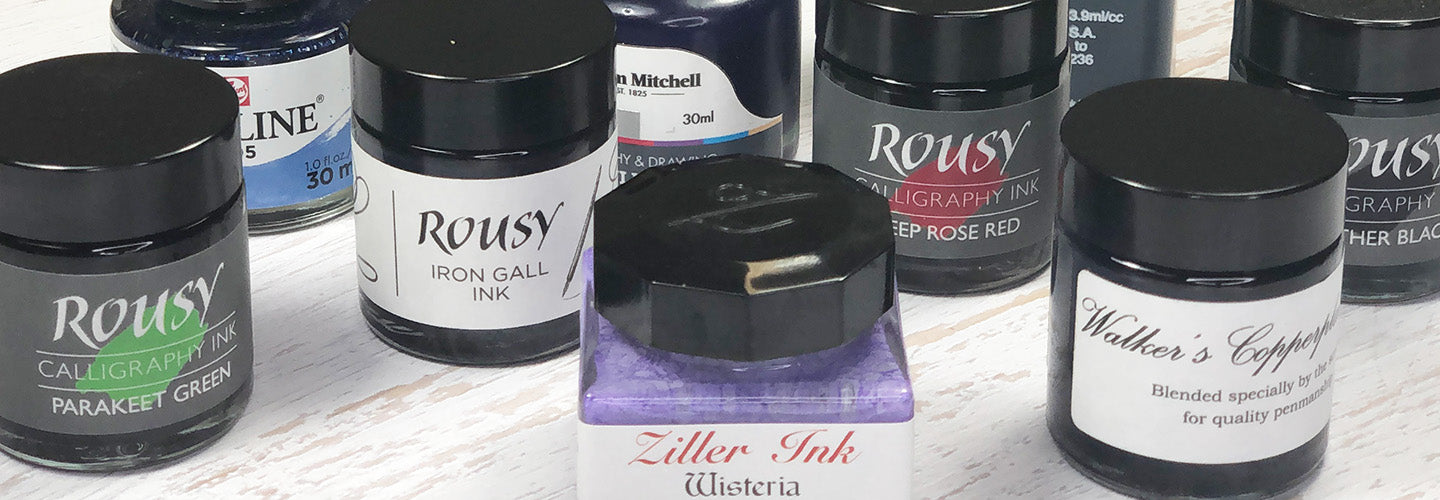
What Can I Put In My Pen?
If you use a fountain pen, or a cartridge pen, then because of the delicate mechanisms it’s best to stick with the inks recommended for them (which certainly means staying well away from waterproof inks.)
But …. If you use a broad edged pen (such as Mitchell, Brause, Speedball, Tape, Leonardt) or a pointed pen (such as Gillott, Brause EF and many more) then the possibilities are much more interesting!
These pens have simple nibs from to which writing liquids can be added and easily washed off, so all sorts of possibilities await …..
Of course there is a vast array of calligraphy inks on the market. Some are thicker, some runnier, you can even get inks with pearl shine to them.
Ordinarily a waterproof ink is not an ideal choice, because when it dried on your nib it is (of course!) waterproof and therefore needs either scrubbing off of removal with something chemical.
However – if you’re just having fun and learning what you can write with, try the waterproof inks, and make sure you clean your nib before it dries.
Most calligraphers are familiar with writing with gouache. Gouache is a paint which comes in a tube – it’s water soluble and can be diluted to a runny consistency for adding to the nib, and it (usually) write a beautiful opaque line.

But watercolour is lovely too – diluted to a runny consistency and used in the same way as gouache, you can benefit from the delicate shades of watercolour paints. (And try using one colour, then adding another without cleaning your nib – and see how the lettering changes from one colour to the next. It’s sometimes sudden, sometimes gradual – well worth playing).

Modern food colouring is often in a paste format – not so good for the calligrapher. But the older style of coloured liquid in a bottle is great to use as a cheap ink – they mix together too, and if you felt the need to write on food they’d be perfect!
We tend not to use fountain pen ink in a dip pen because it can be too runny, or drawing inks because they’re too thick – but if we’re experimenting – why not? It’s also worth diluting the inks to see what happens. Some inks (such as Ziller Glossy black) can take an incredible amount of dilution before they become pale.
Speaking of very dilute liquids, there’s something satisfying about writing with the dirty water from your water jar – subtle greys and other colours can look beautiful and no-one need know that the “ink” was your waste water!

If you’ve not tried it, dilute bleach in the pen is fun. Paint a block of black using fountain pen ink and let it dry. They write over it with the dilute bleach, and you’re likely to see oranges, browns and even blues and greens appear where the bleach reacts with the ink.

Today we tend to expect to buy paints and inks, but our predecessors would have made their own using ingredients from the home and garden. The internet is full of recipes – simple and complex – for making homemade inks: why not give them a try?
And finally just coming back from the “mad scientist” suggestions, of course a broad edged or pointed pen is perfect for writing with masking fluid or with gesso or other liquids to which gold will be applied.
Just make sure your nib is meticulously cleaned after using these liquids, to make sure it doesn’t corrode and is ready for you to use next time.
These are just suggestions – it would be great to know what you’ve discovered works well in your pen.
Shop our range of Inks or Dip Pens and Nibs.
